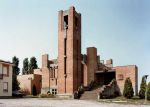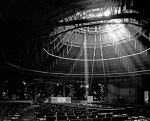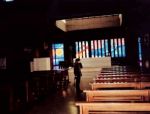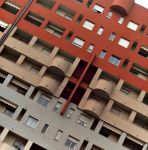A great architect, a great scholar, a great "Ferrarese"
 Carlo Bassi enjoys defining himself as a "militant architect" because this precisely fits his concept of being an "all-round architect". He began to study architecture in 1942-43, far from home, when bombs were falling on Milan. Architecture was (and is) the motivation behind all his ambitions and inspirations: «It made me imagine and construct buildings, that is to say, invent spaces. Imagining and studying the stories of cities urged me to write books, to cultivate the arts, particularly literature and poetry» - he remarks. In the nineteen fifties, together with Goffredo Boschetti,
Carlo Bassi enjoys defining himself as a "militant architect" because this precisely fits his concept of being an "all-round architect". He began to study architecture in 1942-43, far from home, when bombs were falling on Milan. Architecture was (and is) the motivation behind all his ambitions and inspirations: «It made me imagine and construct buildings, that is to say, invent spaces. Imagining and studying the stories of cities urged me to write books, to cultivate the arts, particularly literature and poetry» - he remarks. In the nineteen fifties, together with Goffredo Boschetti,  colleague and life-long friend from Pilastri near Ferrara, he opened a partnership that started business with a prestigious success: almost immediately he was acclaimed as winner in the first national competition in architecture, announced after the end of the second World War, for the design of the new Gallery of Modern and Contemporary Art in Turin.
colleague and life-long friend from Pilastri near Ferrara, he opened a partnership that started business with a prestigious success: almost immediately he was acclaimed as winner in the first national competition in architecture, announced after the end of the second World War, for the design of the new Gallery of Modern and Contemporary Art in Turin.
In Milan, the Bassi-Boschetti partnership mainly worked on social housing projects and for the Office of the New Diocesan Church: for example, they designed the splendid church of the Guardian Angels in Via Colletta, planned in the years prior to the second Vatican Council.  For the Province of Bologna they created the Psycho-Pedagogical Medical Institute 'Sante Zennaro', «then, finally – states Carlo Bassi – Ferrara appears in my curriculum». In the mid-seventies an unexpected call requested the partnership to urgently design the headquarters of the 'Banca di Credito Agrario' in the Magrini palace in Corso Giovecca, now the central office of the Cassa di Risparmio. The result is a building with unique characteristics that led to other prestigious assignments. Carlo Bassi also worked in the planning group for the complete restoration of the church of
For the Province of Bologna they created the Psycho-Pedagogical Medical Institute 'Sante Zennaro', «then, finally – states Carlo Bassi – Ferrara appears in my curriculum». In the mid-seventies an unexpected call requested the partnership to urgently design the headquarters of the 'Banca di Credito Agrario' in the Magrini palace in Corso Giovecca, now the central office of the Cassa di Risparmio. The result is a building with unique characteristics that led to other prestigious assignments. Carlo Bassi also worked in the planning group for the complete restoration of the church of  St. Christopher in the Certosa di Ferrara, financially supported by the Fondazione Cassa di Risparmio di Ferrara, with extraordinary results. Along with this "emergency planning" we can admire the re- sults of sixty years of work: the honorary citizenship of the City of Baltimore in the United States, the Gold Medal at the In- ternational Committee of the XIII Triennale in Milan, highly significant
St. Christopher in the Certosa di Ferrara, financially supported by the Fondazione Cassa di Risparmio di Ferrara, with extraordinary results. Along with this "emergency planning" we can admire the re- sults of sixty years of work: the honorary citizenship of the City of Baltimore in the United States, the Gold Medal at the In- ternational Committee of the XIII Triennale in Milan, highly significant  positions in architectural competitions. The ten churches built for the Diocese of Milan, Mantua and Bologna, the new sacristy in the Cathedral of Ferrara, together with the architect Massimo Dalla Torre. Carlo Bassi devoted special at- tention to the location of the Madonna di Piazza, with a plaque inscribed with his own words, to honour the death of more than a thousand unarmed citizens under "friendly-fire" bomb- ings during the Second World War. Then the books and the one hundred articles published in journals, magazines and newspapers, devoted to the prob- lems of the city, architecture and the arts. He also won the Lerici prize for poetry in 1989 with the poem 'Six verses for Biagio Rossetti'. He has written eight books on Ferrara, to which we must add the large volume of architectural history 'Percorsi nella storia della città e dell'architettura' published by Bovolenta-Zanichelli and the non-fiction novel 'La morte di Le Corbusier'. In conclusion, we must remember the construction of the church of Villa Fulvia in Ferrara, dedicated to the Blessed Giovanni Tavelli da Tossignano. The last demonstration of his commitment to architecture and the architecture of his city.
positions in architectural competitions. The ten churches built for the Diocese of Milan, Mantua and Bologna, the new sacristy in the Cathedral of Ferrara, together with the architect Massimo Dalla Torre. Carlo Bassi devoted special at- tention to the location of the Madonna di Piazza, with a plaque inscribed with his own words, to honour the death of more than a thousand unarmed citizens under "friendly-fire" bomb- ings during the Second World War. Then the books and the one hundred articles published in journals, magazines and newspapers, devoted to the prob- lems of the city, architecture and the arts. He also won the Lerici prize for poetry in 1989 with the poem 'Six verses for Biagio Rossetti'. He has written eight books on Ferrara, to which we must add the large volume of architectural history 'Percorsi nella storia della città e dell'architettura' published by Bovolenta-Zanichelli and the non-fiction novel 'La morte di Le Corbusier'. In conclusion, we must remember the construction of the church of Villa Fulvia in Ferrara, dedicated to the Blessed Giovanni Tavelli da Tossignano. The last demonstration of his commitment to architecture and the architecture of his city.








